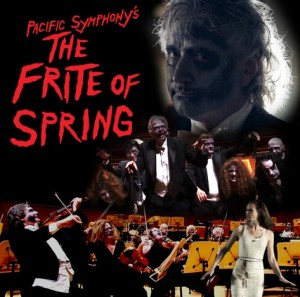This week: A solo Beethoven marathon, the Frite of Spring, a new Kennedy CD. Plus two out-there festivals, and a thorough — definitive — debunking of the idea that studying music raises kids’ test scores.
Debunked
The last item first. One problem we have in classical music, if you ask me, is that we pat ourselves on the back, when we think how wonderful — and how helpful to humanity — our music supposedly is. Not that I’m saying the music isn’t wonderful, but we should be careful not to make extravagant claims for it.
One of these claims, supposedly bolstered by studies, is that studying music increases kids’ test scores. But a new study explodes that notion.
Yes, students who study music have higher test scores than those who don’t study it. But now remove from the statistical pool everyone who’s a high academic achiever, or who comes from an upscale home. Remove, in other words, everyone who’d be expected to do better than average on tests, whether they studied music or not.
The result? The remaining students, all of them studying music, have scorse no higher than anyone else. So music study doesn’t raise scores. The connection between test scores and music in fact goes the other way. Students who do well on tests are the ones more likely to study music.
End of a myth.
Frite!
 So many celebrations of the Rite of Spring! But this one has to take some kind of prize — a mashup of the Rite and “Thriller,” created by the musicians of the Pacific Symphony. Click the link to see it. You’ll find a full-fledged music video, professionally produced. The orchestra starts playing the Rite. Soon a rock beat starts, and the players turn into zombies, surging into the hall to chase a woman in the audience, whom they’ve chosen for the sacrifice. So witty, so well done, such a great way to bring classical music back into the rest of our world, into the cultural space where “Thriller” is a classic. And with so much feeling for the power the Stravinsky score still has.
So many celebrations of the Rite of Spring! But this one has to take some kind of prize — a mashup of the Rite and “Thriller,” created by the musicians of the Pacific Symphony. Click the link to see it. You’ll find a full-fledged music video, professionally produced. The orchestra starts playing the Rite. Soon a rock beat starts, and the players turn into zombies, surging into the hall to chase a woman in the audience, whom they’ve chosen for the sacrifice. So witty, so well done, such a great way to bring classical music back into the rest of our world, into the cultural space where “Thriller” is a classic. And with so much feeling for the power the Stravinsky score still has.
Some people, I fear, will be bothered by cuts in the piece. But please! This is fun, not scholarship, and the cuts are expertly made.
The Frite will be screened outside the Pacific Symphony’s concert hall on June 8, right after their concert. Which shows they’re not afraid to mix their performances with their fun.
And there’s a special bonus. Watch the bassoonist playing the opening solo. See how she moves! She puts her whole body into her playing, as nonclassical musicians so often do. Along with the musicians of the Berlin Philharmonic! While other orchestras — most of the ones we know — would tell their players not to move.
Solo marathon
 Stewart Goodyear, a Canadian pianist and composer with an active concert career has wanted for years to do something that sounds impossible — play all the Beethoven sonatas in public on a single day.
Stewart Goodyear, a Canadian pianist and composer with an active concert career has wanted for years to do something that sounds impossible — play all the Beethoven sonatas in public on a single day.
And now he’s doing it. Last year in Ottawa (to wild acclaim, I’ve heard), and this year in three US venues, in Princeton, Dallas, and Davis, CA.
This draws attention to classical music, because it’s more than just a performance of masterworks. It’s a wildly audacious personal feat.
And Stewart plays Beethoven wonderfully. As you can see, he’s recorded the sonatas. And I’ve previously put on this blog (and in my newsletter) links to the two movements — first one here, second here — of Op. 111.
Tanglewood relay run
The Boston Symphony organized this — a 24-hour relay race, going from Symphony Hall in Boston to the orchestra’s summer home in the Berkshires. Why? To publicize the start of the summer season, and to raise money for the BSO’s education and youth programs.
Not remarkable, you might say. Everyone has charity runs. But orchestras are only starting to do things like this, which makes it a small milestone in (again) classical music’s slow, steady move toward rejoining our culture.
Ending on a downer
Orchestras’ problems — will they never end? “Nashville Symphony revenue drops 50 percent, losses mount in 2012,” shouts a headline in the Tennessean newspaper.
And the story under it is grim (a word the writer doesn’t hesitate to use). The orchestra ran an $11.5 million deficit. Contributions dropped 28%, investment income (from the Symphony’s endowment, I assume) dropped 66%.
There’s nothing in the story about ticket sales. For all I know, they’re healthy. But what’s truly grim, exceptionally so, is the financial disaster that the orchestra’s concert hall turned into. The hall — the Schermerhorn Symphony Center — was the Symphony’s pride and joy when it opened in 2006. And still is, if you believe the orchestra’s website.
But the orchestra can’t make payments on the debt it incurred when it built the hall. So the bank holding the debt might foreclose — seize the hall, take ownership away from the orchestra. Or the orchestra might declare bankruptcy, to stop that happening. Either way, the picture isn’t pleasant.
I posted this Thursday night. Today, Friday, came more news: the bank foreclosed. Now, unless the orchestra declares bankruptcy, the hall will be put up for sale, so the bank can recoup its losses.
The quotes in today’s story were, in a quiet way, priceless. Says the orchestra:
Negotiations with the bank group are continuing, and the Symphony and its Financial Advisory Committee remain squarely focused on achieving a resolution that positions the Symphony for long-term stability,
Says the bank:
The bank group has been in discussions for some time with the orchestra to help it resolve its debt on an acceptable basis and operate at a sustainable level. However, [the Nashville Symphony Association] is in default and has been unwilling or unable to repay the debt.
The orchestra, in other words, can claim anything it wants, but the bank says — publicly — that there’s no more room for negotiating. Which makes the orchestra look even worse. Especially when its auditors, as the story also says, question whether it can stay in business. (Or, as they put it, continue as a “going concern.”)
How did things ever get this bad? Add a scathing indictment of the Minnesota Symphony’s management that recently appeared — bitterly scathing, and, on its face, very hard to refute — and you have to wonder how many other orchestral disasters might be waiting to explode.

Thank you so much Greg for mentioning our Frite of Spring music video. I am the Director of Audience Engagement for Pacific Symphony and you are a personal inspiration to me so it pleases me very much hearing you speak so highly of our work.
The back story on how this came to be is really interesting so I thought I would share. We launched something called The ReRite of Spring Project (http://www.reriteofspring.org), which was aimed at getting the public to create new works in any medium using The Rite as inspiration. When Bridget Dolkas and Alice Wrate, two of the violinists in our orchestra saw the call, they approached me and asked if the musicians could submit something? I said of course! They initially wouldn’t tell me the idea as they wanted it to be kept secret and a surprise for the staff, but they wanted money to implement it. When I said I needed more information, finally they said, we want to mash up The Rite of Spring and Thriller and call it The Frite of Spring. Logistically it was impossible for them to do alone without support to pull it off. However, in the spirit of their request, we only brought in a few key players at the staff level. Bridget, Alice and I then became collaborators . We devised the story line around the loose original idea and each took on different roles and we recruited others for the things we could not do ourselves, like the choreography, etc. We were fortunate to find a young and talented Director/Cinematographer/Editor named Luke Stirtz (http://www.lukestirtz.com/) who got excited about the project and he really made this come together.
On the morning of May 29, 2013, the 100th anniversary of the premiere of The Rite of Spring, I uploaded the video to the Symphony’s YouTube Channel and facebook page. Before I could get an e-mail out to the staff about it, I could hear cackling around the office as it appeared in people’s facebook feeds. It was a great day!! The staff has embraced it. Management has embraced it and many Board members have expressed kudos for a job well done. I work for a great organization which allows me to take risks. Thankfully we have a Music Director and management which places great trust in their people. However, the main reason this worked was because the musicians wanted it to. They believed in it and they donated their time to make it happen. It is a privilege to work with them and in service of their great music making!
There’s no reason an orchestra has to perform in a special built concert hall. Orchestras should be mobile. There’s no reason classical musicians need to dress formally if they will largely perform in informal surroundings. There’s no reason orchestras have to run a deficit unless they are intent on duplicating the failures of promulgating classical museums. Much like the decline of newspapers, physical books, television viewing, formal education, and social interaction, today’s humanity is absorbed in virtual interaction, and until that changes, classical music will adapt to be relevant to it’s age, as it has always done. Point being, one must look outside and beyond their comfort zone, no matter how uncomfortable that may be to find what is relevant today.